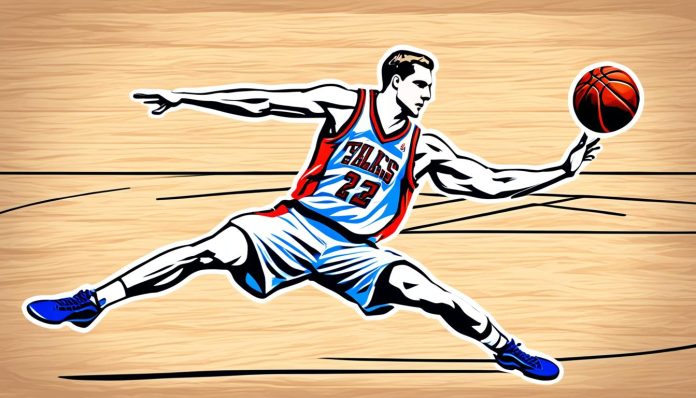In basketball, “travel” means moving without bouncing the ball. It’s against the rules. Players might call it “walking” or “steps.” Different basketball organizations, like the NBA, NCAA, and FIBA, watch for this. Each has its own way of handling this rule.
The NBA and FIBA say players can’t move without dribbling, except for two steps. The NCAA and NFHS have stricter rules. They let a player pivot with either foot since they catch the ball. The NBA requires the ball to be thrown again before that foot touches the floor. Also, NFHS rules say you can’t roll or try to stand with the ball after falling.
Key Takeaways
- Traveling in basketball, also known as walking, occurs when there are too many steps taken without dribbling.
- The NBA and FIBA frequently call traveling for more than two steps without a dribble.
- The NCAA rules allow for pivoting on either foot, enhancing flexibility in handling the ball.
- NFHS rules are notably stringent, adding clauses against rolling or trying to stand while holding the ball after falling.
- Understanding the nuances of traveling violations is crucial for both players and enthusiasts to appreciate the game’s regulatory structure.
The Fundamentals of Traveling Violations in Basketball
In basketball, knowing about traveling violations and the pivot foot is very important. It keeps the game fair. These rules are key for fair play at all levels of the sport.
Defining the Pivot Foot in Basketball
In basketball, your pivot foot is the one that stays on the floor when you stop dribbling. You can turn but not start moving with it or you break the rules. This rule stops players from making illegal moves and keeps the game going smoothly.
Consequences of Lifting the Pivot Foot
If a player lifts their pivot foot wrong, it’s a traveling violation. This means the other team gets the ball. It can mess up an offensive play and give the other team the upper hand.
How the Pivot Foot Differs in NBA, NCAA, and FIBA
The rules on using the pivot foot change a bit in the NBA, NCAA, and FIBA:
- NBA: Players can lift the pivot foot to pass or shoot, but they must release the ball first.
- NCAA: In the NCAA, the ball must be passed or shot before the pivot foot lands again after lifting.
- FIBA: FIBA rules include a gather step that lets players move a bit before they shoot or pass.
Examples of Legal and Illegal Pivot Foot Movements
Knowing what’s okay and not okay with your pivot foot can help you not get those traveling penalties. Here are some pointers:
| Legal Movements | Illegal Movements |
|---|---|
| Spinning around the pivot foot without lifting it | Dragging the pivot foot across the floor |
| Lifting the pivot foot during a shot or pass attempt | Switching the pivot foot without dribbling |
| Hopping on the pivot foot to reposition for passing | Jumping and landing before releasing the ball |
In basketball, travel violations are complex, especially about the pivot foot. Players need to really watch their steps and how they handle the ball. To play well and by the rules, coaches and players should always know the latest rule updates from their leagues.
Common Misconceptions and Clarifications About Traveling
Knowing basketball rules, like those about traveling, can be tough. It’s like trying to do a perfect pivot. Many people, including players and fans, are confused about traveling. A big mistake people make is thinking you can move your pivot foot before dribbling. But, this is really a travel violation and not allowed. It’s important to clear up these confusions. This helps everyone understand the game’s rules better.
Some think that the NBA doesn’t care much about traveling. But each level of play, from the NBA to college and international games, sticks to strict traveling rules. This shows that the sport is fair for everyone, whether you’re playing for fun or as a pro. Knowing these differences is key. It shows how serious basketball is, no matter where you play.
It’s very important that basketball lovers know and understand these rules. This stops wrong ideas about traveling from spreading. And, it makes watching and playing basketball more fun. When everyone knows the rules, the game is fair and great for all. So, learning the rules is as vital as playing well.












































